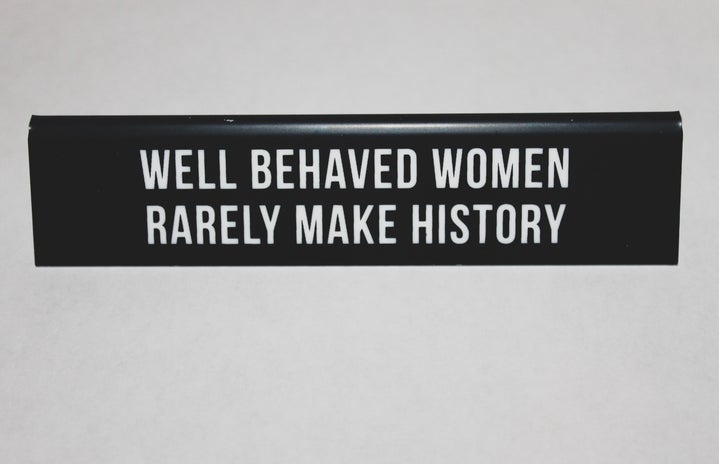Hollywood has a problem. Actually, that’s an understatement, Hollywood has an insane amount of problems. It refuses to award movies made by and starring people of color, although they are equally, if not more, deserving of recognition (I’m looking at you, Selma). They treat actors of a certain age, particularly women, like expired cartons of milk that have a sell-by date. They prominently favor males in every field, from directors and producers all the way down to gaffers and best boys (it’s literally even in the name). However, all of these problems, while terrible and in serious need of acknowledgment and change by the industry, are at least being talked about in some capacity. There is a call for change, even if the industry isn’t really listening yet. There is one problem, however, that because of how ingrained it is in our culture, it’s not really talked about with any real interest: the problem of the Hollywood “It Girl.”
The problem is not really in the existence of the “It Girl.” Celebrities and our culture’s way of worshipping them are not great, but that’s not the real issue. The problem is the continuing trend of worshipping one “It Girl” at a time and the discarding of those we deem overused or no longer likeable. The mostly complete acceptance of this trend is baffling. We all go along with it, as if this is just the way it is. Sure, every few years someone writes an article or makes a note on how terribly we as a society treat these actresses, especially after we’ve decided that we’re done with them, but for the most part we all just accept that this is how it works.
A young woman comes out of seemingly nowhere onto the acting scene, stars in some critically-acclaimed films, then as she starts getting more and more high-profile parts, she starts garnering a lot of attention. Usually she is charming and interesting in some way, maybe because she’s relatable and down-to-earth and can eat an entire pizza while wearing sweatpants (she’s just like us!), or maybe because she’s more of a quirky eccentric, eating clay to clear herself of toxins and sunbathing bottomless to let her vagina absorb nutrients (seriously, those are both things actress Shailene Woodley has claimed to do).
Before these modern archetypes there were old-timey equivalents with the “America’s Sweetheart” and the “Sexy Bombshell,” both different sides to the same sexist coin. No matter what era of Hollywood you look at, the results of these archetypes are the same. After a few years (or even months), we start getting tired of these women. Tabloids start saying things like “Is [insert woman here] secretly a diva?”, or “[blank] was caught saying this in an interview, is the fame getting to her?” We start chipping away at the seemingly infallible reputation they had just weeks before. Sometimes we even start pointing out their physical flaws as an excuse to dislike them, like “Anne Hathaway’s teeth are too big!” or “Megan Fox has weird thumbs!”.
We either destroy them ourselves through gossip and a mob mentality of hate or we watch them implode, usually through an addiction or mental breakdown of some sort. No matter what, it seems we always find a way to kick these women off of the pedestals that WE put them on in the first place. The most obvious and recent example would be the new turn against Jennifer Lawrence. Just a year ago we were all sharing articles and GIFs about how relatable she is; now she snaps at a reporter and we’ve started discussing whether she’s reached her peak and if the reign of Lawrence is over. We chew these women up and spit them out, our love for them fading just as fast as it came.
This trend is nothing new. It’s been happening since the dawn of film, with silent film star Clara Bow being the first to hold the title. As the first “It Girl” (the name even comes from one of her movies), she was adored and treated like royalty until she was kicked off the map for showing flaws in her personal life (a rumor of alleged affairs with two prostitutes and a football team are a few examples).
She was then easily replaced by “blonde bombshell” Jean Harlow and thrown back down to where she started, if not worse. This pattern has been happening now for a full century, starting with Bow and continuing with stars like Judy Garland, Marilyn Monroe and Elizabeth Taylor, women we built up and then threw away, usually to their own demons and addictions. This can be seen in more recent “It Girls” as well, with Lindsay Lohan, Amanda Bynes and Britney Spears suffering mental breakdowns in the public eye and being met with ridicule and disgust rather than support, or at least privacy.
This doesn’t just go for those who have meltdowns either. Most female celebrities that were once considered to be at the top of industry were eventually pushed aside for coming across as “annoying” or “unlikeable.” They said or did something unfavorable, or perhaps just became boring to us, leading to them being replaced by a different (but similarly white and thin) “It Girl.” Julia Roberts, Kate Winslet, Gwyneth Paltrow, Nicole Kidman, Catherine Zeta-Jones, Jennifer Aniston, Anne Hathaway, Natalie Portman, Zooey Deschanel and now Jennifer Lawrence can all attest to this. Of course, all of these actresses still get work and are still considered celebrities, but you would be hard-pressed to find someone who isn’t annoyed by at least one of these women, myself included. They are no longer infallible in our eyes. We say they are out-of-touch or overused, we say they are uppity, weird, rude or fat, and hearing that they were cast in some movie or TV show causes us to groan and complain that she’ll ruin it with her weird, rude, fatness.
Again, WHY DO WE DO THIS? A comparable list of male actors with similar careers would, to put it lightly, not cause quite the same reaction. George Clooney, Leonardo DiCaprio, Johnny Depp, Brad Pitt, Will Smith, Matt Damon and newly-inducted Chris Pratt are all still (for the most part) universally loved, even after making movies that sucked, going through messy divorces or garnering tabloid scandals. We grant this same level of nearly unfailing respect to men who beat women (Sean Penn), men who have violent fits of rage (Russell Crowe), men who cheat on their wives (Ben Affleck) and even men who were convicted of attempted murder (Mark Wahlberg). The list of male actors who have been accused of abusing their wives and girlfriends is probably longer than this article, and yet we turn a blind eye to it because, hey, they can act, and they sure are handsome. The fact that we would probably literally let our favorite male actors get away with murder while we expect female actors in the same league to exhibit near perfection is ridiculous, and yet most of the time we don’t even stop to think about it. These men should be under just as much scrutiny, and yet we let them all continue to be terrible people, or at the very least we let them be flawed and human. (Except for Chris Pratt. You’re still perfect, never change).
This is not to say that all actresses are immediately discarded after one bad mistake or that actresses are above scrutiny (both Jennifer Lawrence and Shailene Woodley have said some actual terrible things that deserve attention). It’s alright for us all to acknowledge that celebrities, both male and female, are not perfect. It’s also important, however, to take a step back and figure out why exactly we look at these women with the level of scrutiny that we do while granting male celebrities the ability to do almost anything without consequence. When you find yourself thinking, “Man, Jennifer Lawrence is getting kind of annoying,” are you thinking that because it’s true, or are you thinking that because we are programmed to find female celebrities unlikeable after a certain period of time? It’s very possible to just not like a female celebrity — we are human and they are human and sometimes we just don’t like people, plain and simple. The problem is finding the line between disliking an actress for being unlikeable versus disliking an actress because we’ve been trained as a society to throw them away. This train of “It Girls” will not be coming to an end any time soon, with articles already popping up about who will dethrone Lawrence (bets are on Room star Brie Larson). But why does it have to be this way at all?
We pit these women against each other like their job is to fight to the death for our affection rather than to, you know, act in movies. Is there not enough roles in Hollywood for more than a few likeable, young, female celebrities at a time? There’s enough room for actors like Johnny Depp and Adam Sandler to keep releasing terrible crap-fests every year without stopping; there should be enough room left over for more than one “adorkable” or sexy actress at a time.
The next time you see an article about a new Hollywood “It Girl,” maybe take a second to think of where the last one went, because chances are she did nothing beyond having the nerve to exist and age beyond what we find acceptable.


